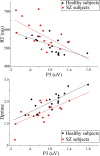Normal electrocortical facilitation but abnormal target identification during visual sustained attention in schizophrenia
- PMID: 19074014
- PMCID: PMC6671741
- DOI: 10.1523/JNEUROSCI.4095-08.2008
Normal electrocortical facilitation but abnormal target identification during visual sustained attention in schizophrenia
Abstract
Attentional deficits in schizophrenia have been investigated using target identification tasks which conflate the abilities to successfully (1) attend to possible target locations and (2) detect target events. Whether compromised attentional selectivity or abnormal target detection causes schizophrenia subjects' poor performance on visual attention tasks, therefore, is unknown. To address this issue, we measured the neural activity (using electroencephalography) of 17 schizophrenia and 17 healthy subjects during a target identification task. Participants viewed superimposed images (horizontal and vertical bars differing in color) and attended to one image to identify bar width changes in specific locations. Bars were frequency tagged so attention directed to unique parts of the images could be tracked. Steady-state visual evoked potentials (ssVEPs) were used to quantify attention-related neural activity to specific parts of the visual images. Behavioral performance and event-related potentials (ERPs) in response to the target events were used to quantify target detection abilities. For both schizophrenia and healthy subjects, attending to specific parts of the attended image enhanced brain activity related to attended bars and reduced activity evoked by unattended bars. Activity in relation to the spatially overlapping unattended image was unaffected. Schizophrenia patients, however, were impaired on target detection abilities on both behavioral and brain activity measures. Target-related behavioral and brain activity measures were highly correlated in both groups. These findings indicate that deficient target detection rather than compromised attentional selectivity accounts for previously reported visual attention deficits in schizophrenia.
Figures






Similar articles
-
The neural correlates of feature-based selective attention when viewing spatially and temporally overlapping images.Neuropsychologia. 2007 Apr 8;45(7):1393-9. doi: 10.1016/j.neuropsychologia.2006.10.019. Epub 2006 Dec 11. Neuropsychologia. 2007. PMID: 17161441 Free PMC article.
-
Attentional Selection of Feature Conjunctions Is Accomplished by Parallel and Independent Selection of Single Features.J Neurosci. 2015 Jul 8;35(27):9912-9. doi: 10.1523/JNEUROSCI.5268-14.2015. J Neurosci. 2015. PMID: 26156992 Free PMC article.
-
Concurrent recording of steady-state and transient event-related potentials as indices of visual-spatial selective attention.Clin Neurophysiol. 2000 Sep;111(9):1544-52. doi: 10.1016/s1388-2457(00)00371-0. Clin Neurophysiol. 2000. PMID: 10964063
-
On the role of selective attention in visual perception.Proc Natl Acad Sci U S A. 1998 Feb 3;95(3):825-30. doi: 10.1073/pnas.95.3.825. Proc Natl Acad Sci U S A. 1998. PMID: 9448247 Free PMC article. Review.
-
Steady-State Visually Evoked Potentials and Feature-based Attention: Preregistered Null Results and a Focused Review of Methodological Considerations.J Cogn Neurosci. 2021 Apr;33(4):695-724. doi: 10.1162/jocn_a_01665. Epub 2021 Jan 8. J Cogn Neurosci. 2021. PMID: 33416444 Free PMC article. Review.
Cited by
-
Impact of ketamine on neuronal network dynamics: translational modeling of schizophrenia-relevant deficits.CNS Neurosci Ther. 2013 Jun;19(6):437-47. doi: 10.1111/cns.12081. Epub 2013 Apr 24. CNS Neurosci Ther. 2013. PMID: 23611295 Free PMC article. Review.
-
Event-related potential abnormalities in schizophrenia: a failure to "gate in" salient information?Schizophr Res. 2009 Sep;113(2-3):332-8. doi: 10.1016/j.schres.2009.06.012. Epub 2009 Jul 23. Schizophr Res. 2009. PMID: 19628376 Free PMC article.
-
Impaired visual cortical plasticity in schizophrenia.Biol Psychiatry. 2012 Mar 15;71(6):512-20. doi: 10.1016/j.biopsych.2012.01.013. Biol Psychiatry. 2012. PMID: 22364738 Free PMC article.
-
Neural oscillatory deficits in schizophrenia predict behavioral and neurocognitive impairments.Front Hum Neurosci. 2015 Jul 1;9:371. doi: 10.3389/fnhum.2015.00371. eCollection 2015. Front Hum Neurosci. 2015. PMID: 26190988 Free PMC article.
-
Bayesian analysis of phase data in EEG and MEG.Elife. 2023 Sep 12;12:e84602. doi: 10.7554/eLife.84602. Elife. 2023. PMID: 37698464 Free PMC article.
References
-
- American Psychiatric Association. Ed 4. Washington, DC: American Psychiatric Association; 1994. Diagnostic and statistical manual of mental disorders.
-
- Brody SA, Conquet F, Geyer MA. Disruption of prepulse inhibition in mice lacking mGluR1. Eur J Neurosci. 2003;18:3361–3366. - PubMed
-
- Camchong J, Dyckman KA, Chapman CE, Yanasak NE, McDowell JE. Basal ganglia-thalamocortical circuitry disruptions in schizophrenia during delayed response tasks. Biol Psychiatry. 2006;60:235–241. - PubMed
Publication types
MeSH terms
Grants and funding
LinkOut - more resources
Full Text Sources
Medical
